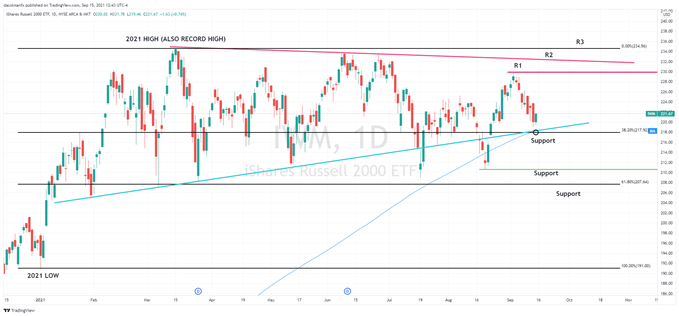Is Russell 2000 About To Stage A Comeback? Will A Cyclical Relief Help IWM?
Inflation can be positive for small-cap and cyclical companies when it is accompanied with strong economic growth. On the flip side, when inflation runs hot, it is supply-driven and economic activity starts to disappoint, small-caps don’t tend to perform well as mounting price pressures eat into profit margins rapidly.
In early summer, as U.S. CPI touched its highest levels in a generation and delta-variant fears caused output to start downshifting, the specter of “stagflation” spooked investors, prompting traders to cut exposure to cyclical stocks. This fear, whether justified or not, was probably responsible for the Russell 2000's poor performance over the past few months (the Russell 2000 is a cyclically oriented small-cap index).
The good news now is that inflation appears to be easing after supercharged readings earlier in the year. This dynamic may alleviate pressure on margins and create a friendlier setting for small caps with little pricing power.
With inflationary pressures losing some impetus, there could soon be a rotation into cyclicals and small-caps again, a scenario that stands to benefit the Russell 2000. The bullish thesis, however, is based on the conjecture that the recovery will stabilize and the labor market will improve in the coming months.
Investors and consumers have become overly gloomy about the economy on account of the latest COVID-19 wave driven by the delta-variant, but the pessimism is misguided as the health crisis will not get out of hand with effective vaccines and broadening inoculations. On this point, it is important to note that vaccines for small children are slated for approval in late October. This should further improve the situation.
Looking ahead to the fourth quarter, encouraging stories about falling coronavirus cases should dominate the news cycle, boosting consumer confidence and household spending. This, in turn, should be good news for the labor market and GDP (as a side note, consumers maintain a healthy balance sheet with ~$2.4T excess savings according to JP Morgan).
While we will not match the outstanding performance achieved during the first and second quarter, when the fiscal stimulus was in full swing, the economy should still expand at a healthy pace going forward. Granted, slower growth may translate into lower equity returns, but the macroeconomic environment, Fed flexibility, and above-trend expansion forecast through 2022 are still consistent with positive equity returns and cyclical relief. This may leave the Russell 2000 in a good position to cruise higher over the medium term, but any upside move will not likely have the explosive momentum seen during the peak of cyclical optimism earlier this year.
IWM - A PROXY FOR THE RUSSELL 2000
One way to trade equity indexes is via ETFs. When looking at the Russell 2000, the IWM ETF tracks its performance and its generally used as the small-cap index’s proxy.
Focusing on IWM recent price action, we can see that the EFT is approaching its 200-day moving average and Fibonacci support near 218 (38.2% Fib retracement of the 2021 ascent). In this area, buyers could regain control of the market and trigger a move towards the September high at 230. Should this technical barrier be taken out, the IWM could be on its way to recover its record high near 235.
On the flip side, if IWM continues the recent pullback and drops below 218, the bullish thesis could unravel temporarily, at least from a technical point of view. Under this scenario, the EFT could head towards the next support at 210 in the near term (August low).
IWM TECHNICAL CHART
Disclaimer: See the full disclosure for DailyFX here.




